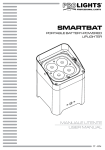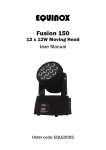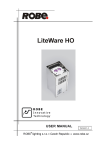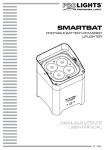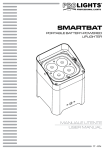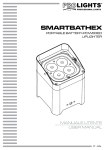Download Euro Kitchen Appliances PS101-30 User manual
Transcript
PS-101 User Manual Plug-In Smoke Alarm 10 Year Life CONTENTS Introduction Page 2 Sensor technology 2 Application and positioning 3 Limitations 4 How to install your FireAngel 1. Remove shipping disablement ribbon 2. Locate suitable lighting fixture a) Orientation b) Type & Position c) Lampshade d) Lightbulbs 3. Install your FireAngel a) Conventional type lampshades b) Uplighter type lampshades 4. Fully charge your FireAngel 5. Test your FireAngel Operation Low battery Condition Alarm test Alarm silence Routine Maintenance Cleaning 5 5 5 5 6 6 7 7 7 8&9 10 10 Page 11 11 11 12 13 13 & 14 Repair 15 Trouble shooting 15 What to do in case of fire in your home How to make your home safer 16 17 & 18 Warranty 19 Returns 19 Refit shipping disable ribbon 20 Note: This User Manual is also available in large text and other formats. Please call 024 7623 6663 for further information. 1 INTRODUCTION This manual is for use with models PS-101 (white) and SPS-101 (silver) Plug-in Smoke Alarms. Note, that for information purposes, the PS-101 only has been used. Congratulations, you've made a wise investment in an innovative product and your personal safety. The FireAngel plug in smoke alarm is the first in a new generation of domestic life safety products from Sprue Aegis, which combines the latest technology and innovative design to provide an aesthetically pleasing and effective contribution to your fire safety. The FireAngel range of products is constantly being improved and expanded. Please visit www.fireangel.co.uk to find out about the latest additions to our product range and futher technical information. This user manual contains important information regarding the operation of your FireAngel Smoke Alarm. If you are installing this smoke alarm for use by someone else, you must leave this manual (or a copy of it) with the end user. SENSOR TECHNOLOGY Your FireAngel Plug-In Smoke Alarm uses an ionisation type sensor to detect the presence of smoke. Ionisation type smoke alarms are generally more effective at detecting fast, flaming fires which consume combustible materials rapidly and spread fire quickly. To increase the level of protection you should also install photoelectric type smoke alarms that are more effective at detecting slow burning fires, which smoulder for hours before bursting into flames. For maximum protection, use both types of smoke alarm on each level of your home 2 FIREANGEL APPLICATION AND POSITIONING The minimum recommended application is one FireAngel to cover each floor and/or escape routes from individual sleeping areas. For comprehensive coverage we recommend one per room with the exception of bathrooms, shower-rooms and kitchens. The moist environments in bathrooms and shower-rooms are not suitable for Smoke Alarms and kitchens should be protected with self-contained Heat Alarms, as the combustion particles from cooking in kitchens will result in false alarms if Smoke Alarms are used. We recommend that rooms where electrical appliances are in continuous operation and bedrooms in which smokers sleep have individual Smoke Alarms. To avoid false alarms, Smoke Alarms should not be located in: • • • • • • Areas where combustion particles may be present such as garages. In areas where air flows may carry combustion particles. To avoid false alarms position the alarm as far away as possible from sources of combustion, in well-ventilated areas. In damp or very humid areas such as near shower or bath rooms, where the moisture in the air may condense in the chamber causing fine droplets which can cause false alarms. In areas where excessive dust or dirt could contaminate the sensing chamber, making it over sensitive or impairing the ingress of smoke. In areas where the ambient room temperature is not controlled and may regularly drift below 40°F (4°C) or above 100°F (38°C) e.g. unheated buildings, open loft spaces. In 'dead air' spaces, see diagram for clarification. 3 WHAT ARE THE LIMITATIONS OF MY SMOKE ALARM? Your FireAngel is designed to alert you by sounding an alarm when it senses smoke, i.e. it can only sense smoke and alert you if smoke reaches it! If a fire develops in an area remote from the location of the FireAngel such as another room or another floor, smoke may not reach the FireAngel in sufficient time or quantity to sense and alert you to the danger. We recommend that as a minimum you install a FireAngel on every floor of your property and additional units as required to cover all escape routes from sleeping areas. The FireAngel requires an electrical supply to recharge its integral battery. If the mains electrical supply fails or is removed the unit will continue to operate on its fully charged battery supply for 60 days. The FireAngel will advise you of a low battery condition by emitting an audible 'chirp' once per minute, when this occurs you must restore the mains supply to the unit within 8 hours to maintain operation. Following restoration of the mains supply the FireAngel batteries will recharge to full capacity from a low battery alarm condition after 8 hours. You can continue to charge beyond 8 hours however. Smoke Alarms are designed to alert you with an audible alarm at a distance specified within the relevant British and European Standards. Closed doors, walls and high ambient noise levels will reduce this distance. Temporary or permanently impaired hearing may result in the alarm not being heard. Test and check that you can hear the alarm in all circumstances. If in doubt install additional smoke alarms as required, which should be interconnected if possible. The FireAngel employs the latest technology and is third party tested as being compliant with all the relevant British and European Standards. However, as with any electronic product it may fail and may not sense all types of fire within sufficient time to alert you of the danger and provide adequate time for your escape. Your FireAngel is only suitable for use in domestic/residential applications as covered in this manual. It is not suitable for commercial or industrial applications. It is designed to sense smoke and alert you. It will not sense carbon monoxide, flames, heat or gas. The FireAngel has a limited life of 10 years and should not be considered as a substitute for life or property insurance. 4 HOW TO INSTALL YOUR FIREANGEL 1. Remove Shipping Disablement Ribbon 1. Hold FireAngel 3. Pull out from base of alarm 2. Unplug ribbon connector 4. Remove ribbon from FireAngel & retain (see page 20) Warning Your FireAngel has been shipped in a disabled state. You must completely remove the shipping disablement ribbon before use. Failure to remove the ribbon will render the FireAngel inoperative in the event of a fire emergency Note: Your fireangel may beep or start chirping once a minute on removal of shipping disablement ribbon. This is normal, read on for clarification. 2. Locate Suitable Lighting Fixture Important Your FireAngel requires a mains supply of electricity to recharge the integral battery. Only install in suitable light fittings that are used regularly. Your FireAngel requires the light to be switched on for a total of 1 hour per week to remain in its fully charged state. Please ensure your home’s electrical wiring is in accordance with BS7671. a) Orientation Your FireAngel is only intended to operate with the bulb underneath. Under no circumstances should your FireAngel be installed upside down. 5 b) Type & Position Your FireAngel is only intended for installation in batten and pendant type bayonet lighting fixtures that allow your FireAngel to hang within 28cm (11 inches) of the ceiling. The closer to the ceiling your FireAngel is fitted, the faster it will respond in a fire emergency. Warning Do not fit your FireAngel in wall-mounted lights, table lamps, standard lamps or any other type of lighting fixture that is not recommended. Failure to comply with this instruction could render the FireAngel inoperative in the event of a fire emergency. c) Lampshade Your FireAngel is only intended for installation within lampshades that allow the flow of air around and through the Alarm. This usually means that the lampshade is open at both ends. The lampshade must be open at the top for two reasons. Firstly to allow smoke to enter the alarm from above and secondly to allow hot air to escape from the bulb and FireAngel. Please refer to the guide below for clarification. Warning Your FireAngel will only alert you to fire emergency situations on sensing smoke. Under no circumstances should you install your FireAngel in spherical paper lanterns or fully sealed (enclosed) lampshades as this could render your FireAngel inoperative in the event of a fire emergency and will invalidate your warranty. 6 d) Lightbulbs Your FireAngel is only intended for use with conventional bayonet light bulbs up to a maximum rating of 60 watts, and long life/low energy (PL Tube) type bulbs of any rating. Warning Using light bulbs above a 60 watt rating will significantly reduce the life span of your FireAngel and invalidate your warranty. 3. Install Your FireAngel a) Conventional type lampshades Ensure the selected light fitting is switched off and that the bulb is cool. a) Remove the bulb from the light fitting. b) Slacken the lampshade fixing skirt, to allow rotation of the lampshade c) Install into pendant ensuring that lampshade arms do not foul. 7 d) Fit the bulb into the aperture provided in the base of your FireAngel. b) ‘Uplighter’ type lampshades Ensure the selected light fitting is switched off and that the bulb is cool. Remove the bulb from the light fitting. a) Remove the lampshade fixing skirt, to allow the removal of the lampshade. c) Fit your FireAngel into the light fitting. b) Place the lampshade’s fixing ring over your FireAngel. Note: care must be taken to avoid the lampshade falling. 8 d) Fit the bulb into the aperture provided in the base of your FireAngel. Important Your FireAngel has been designed to fit within the arms of the majority of lampshades. If the arms on your lampshade are not wide enough apart to allow installation, simply ease apart until your FireAngel can be fitted. Important Your FireAngel has been designed to fit into modern light fixtures that use an average length fixing skirt. In certain cases it may be necessary to upgrade to a smaller lampshade fixing skirt to allow installation. 9 4. Fully Charge Your FireAngel To ensure both the correct operation and maximum life span of your FireAngel it is necessary to fully charge the integral battery on installation. This process is best achieved by leaving the light switched on for at least 8 hrs. Note: Your FireAngel may continue to chirp for up to 30 minutes whilst carrying out the initial charging process. 5. Test Your FireAngel to ensure correct operation ALARM TEST c) After a short delay your FireAngel will emit a minimum of 2 cycles of 3 short bleeps. b) Switch the light off, then on again once in rapid Note: Suitable for use with dimmer switches. Use above succession (1 flick) minimum settings. Important If your FireAngel fails to give an audible test signal, please refer immediately to the troubleshooting guide on page 15 of this manual. If your FireAngel starts chirping once per minute, then you have flicked the lightswitch too many times and your Fireangel has entered into its automatic reset cycle, see page 12 for clarification. a) Switch the light on. Note: During strong thunder storms and interruptions to your mains supply your FireAngel may self test automatically. 10 OPERATION Low Battery Condition Important Your FireAngel requires an electrical supply to recharge its integral battery. Only install in suitable light fittings that are used regularly. Your FireAngel requires the light to be switched on for a total of 1 hour per week to remain in its fully charged state. If the light is not used or the mains electrical supply is removed your FireAngel will continue to operate on its fully charged battery supply for 60 days. Should your FireAngel enter a low battery condition, the unit will emit an audible 'chirp' approximately once per minute. When this occurs you must restore the mains supply to the unit (switch the light on) within 8 hours to maintain correct operation. Following restoration of the mains supply the FireAngel batteries will recharge to full capacity from a low battery alarm condition after 8 hours. Important The failsafe design of your FireAngel means that failure to restore the electrical supply will result in the FireAngel entering a full alarm condition after 14 days. Should this situation occur your FireAngel would require re-charging longer (i.e. 14hrs) to ensure correct future operation. Alarm Test Test your FireAngel at least once per week to ensure correct operation. See instruction on page 10 for clarification. Attention Avoid over exposure to the sounder at close range, which may be harmful to your hearing. 11 Warning NEVER use an open flame to test your FireAngel. The built in test feature accurately tests your FireAngel's operation as required by British Standards (BS). Caution Do not use aerosol smoke to test your FireAngel. Aerosol contaminants can clog your FireAngel and prevent smoke from reaching the sensor in a fire emergency. Alarm Silence If your FireAngel alarms and you are not testing the unit, your FireAngel is warning you of a potentially dangerous situation that requires your immediate attention. Only use the alarm silence function after making sure that there is no ongoing fire emergency situation. Switch the light on. Switch the light off then on again twice in rapid succession (2 flicks). After a short delay your FireAngel will silence and enter into a 12-minute reduced sensitivity reset cycle. During the 12-minute reduced Your FireAngel will sensitivity re-set cycle, your automatically return to full FireAngel will emit an audible sensitivity after 12-minutes. 'chirp' once per minute. NOTE: Your FireAngel is suitable for use with dimmer switches. NOTE: During strong thunder storms and interruptions to your mains supply your FireAngel may enter the alarm reset cycle. 12 Important If your FireAngel continues to 'chirp' after completion of the re-set cycle, it is notifying you of a low battery condition. In this case leave the light switched on for approximately 8 hours to fully re-charge the integral battery. Warning Never ignore any alarm. Ignoring the alarm may result in injury or death. If your FireAngel alarms and you are not absolutely certain of the source of the smoke, get everyone out of the house immediately (see page 16). Routine Maintenance Your FireAngel plug-in smoke alarm has been designed to be as maintenance-free as possible and although the unit requires NO battery maintenance for its entire life, there are several things you must do to keep it working properly. Attention! Your FireAngel is a sealed mains device and no attempt should be made to open the case. Attempting to open the case will invalidate your warranty. Testing Test your FireAngel once a week (see page 10). Cleaning As a minimum your FireAngel should be cleaned once every 3 months using the soft-brush attachment of your vacuum cleaner. a) Ensure the light is switched off and the bulb is cold. b) Using the soft brush attachment of your vacuum cleaner gently remove all signs of dust from the cover and ventilation holes, on both the top and bottom. 13 c) Test to ensure correct operation (see page 10). Important If you are unable to access your FireAngel whilst in its fitted position, remove from lighting fixture and hold in hand whilst cleaning. Ensure the light is switched off and the bulb is cold. Holding the outside of the FireAngel casing in one hand, gently remove the bulb. Gently remove the FireAngel by holding the light fitting in one hand and the outside of the FireAngel in the other. Hold your FireAngel in one hand, using the soft brush attachment of your vacuum cleaner gently remove all signs of dust from the cover and ventilation holes. Replace your FireAngel as per the installation instructions on page 5. Test to ensure correct operation (see page 10). Important It is advisable to clean your FireAngel each time you replace a light bulb, always test your FireAngel to ensure correct operation after any routine maintenance. Warning Your FireAngel uses mains power from the light fitting. As with normal light fittings, if your light bulb has stopped working it may be difficult to ascertain if the electrical supply is turned off. Under no circumstances should you place your fingers in the aperture provided to fit the light bulb in the base of the alarm. Failure to comply with this warning may result in an electric shock. 14 REPAIR • • • • DO NOT attempt to repair your FireAngel, doing so will invalidate your warranty. If your FireAngel is not operating properly, see 'TroubleShooting'. If you cannot solve the problem, and your FireAngel is still under warranty, return your FireAngel to Sprue Aegis (see Warranty). If your FireAngel is no longer under warranty, replace immediately with a comparable FireAngel brand Smoke Alarm. TROUBLE SHOOTING SOLUTION PROBLEM FireAngel alarms when handling during installation/cleaning (possibly excessive static) Allow the bulb to cool. Remove bulb. Remove FireAngel from light fitting. Wipe plastic casing with a slightly damp cloth. Allow any moisture on alarm to dry. Reinstall alarm and bulb. Reset your FireAngel (see Alarm Silence, page 12). FireAngel alarms when no smoke is visible Clean your FireAngel (see Routine Maintenance) . Check the location of your FireAngel (see Application & Positioning). Fully charge your FireAngel (see Installation, section 4). Test your FireAngel (see Installation, section 5). You experience frequent unwanted alarms Clean your FireAngel (see Routine Maintenance). Check the location of your FireAngel (see Application & Positioning). Fully charge your FireAngel (see Installation, section 4). Test your FireAngel (see Installation, section 5). FireAngel 'chirps' intermittently Fully charge your FireAngel (see Installation, section 4). Test your FireAngel (see Installation, section 5). Check to make sure that your FireAngel is installed properly (see Installation). Clean your FireAngel (see Routine Maintenance) Check the location of your FireAngel (see Application & Positioning) FireAngel does not sound during testing Fully charge your FireAngel (see Installation, section 4). Clean your FireAngel (see Routine Maintenance). Check to make sure that your FireAngel is installed properly (see Installation). Test your FireAngel (see Installation, section 5). Confirm that light fitting is receiving electricity when switched on. If you have any questions or concerns please contact the FireAngel Technical Support Team. Eire 1-800-523-171 (Monday - Friday, 10am - 4pm) e-mail: [email protected] Telephone: UK 024 7623 6663 15 WHAT TO DO IN CASE OF FIRE IN YOUR HOME If you have made a family escape plan and practised it with your family, you have increased their chances of escaping safely. Go over the following rules with your children each time you have fire drills. This will help everyone remember them in case of a real emergency. • • • Don't panic; stay calm. Your safe escape may depend on thinking clearly and remembering what you have practiced. • Feel the doors to see if they are hot. If they are not, open them carefully. Do not open a door if it is hot. Use an alternate escape route. • • • • • • • Stay close to the floor. Smoke and hot gases rise. Notify every member in the residence of the fire. Get out of the house as quickly as possible. Follow a planned escape route. Do not stop to collect anything or to get dressed. Cover your nose and mouth with a cloth. (Wet it if possible.) Take short, shallow breaths. Keep doors and windows closed. Open them only if you have to in order to escape. Meet at your planned meeting place after leaving the house. Carry out a headcount. Call the Fire Brigade as soon as possible from outside your house. Dial 999 - it’s free. Give the address and your name. Never go back inside a burning building. Contact your local Fire Brigade. They will give you more ideas about how to make your home safer from fires and how to plan your family's escape. 16 HOW TO MAKE YOUR HOME SAFER Installing smoke alarms is only one step in protecting your family from fires. You must also reduce the chances that fires will start in your home. And you must increase your chances of escaping if one does start. To have a good fire safety program you must: 1. Put up smoke alarms properly. Carefully follow ALL the instructions in this manual. Keep your smoke alarms clean, and test them every week. SMOKE ALARMS THAT DO NOT WORK WILL NOT ALERT YOU. 2. Replace your smoke alarms immediately if they are not working properly. 3. Follow fire safety rules, and prevent hazardous situations: • • • • • Use smoking materials properly. Never smoke in bed. • • • Keep portable heaters and open flames such as candles away from combustible materials. Keep matches and cigarette lighters away from children. Store flammable materials in proper containers. Never use them near open flame or sparks. Keep electrical appliances in good condition. Do not overload electrical circuits. Keep stoves, fireplaces, chimneys, and barbecue grills grease free. Make sure they are properly installed, away from any combustible materials. Do not allow rubbish to accumulate. Keep a supply of extra batteries on hand for your battery powered smoke alarms. 17 4. Develop a family escape plan and practice it with your entire family. Be sure to include small children In your practice. • Draw a floor plan of your home, and find two ways to exit from each room. There should be one way to get out of each room without opening the door. • Explain to children what the smoke alarm signal means. Teach them that they must be prepared to leave the home by themselves if necessary. Show them how to check to see if doors are hot before opening them. Show them how to stay close to the floor, crawl if necessary. Show them how to use the alternate exit if the door is hot and should not be opened. • Decide on a meeting place a safe distance from your house. Make sure that all your children understand that they should go and wait for you there if there is a fire. • • • Hold fire drills at least every 6 months to make sure that everyone, even small children, know what to do to escape safely. Know where to go to call the Fire Brigade from outside your home. Provide emergency equipment, such as fire extinguishers, and teach your family to use this equipment properly. Contact your local Fire Brigade. They will give you more ideas about how to make your home safer from fires and how to plan your family's escape. 18 10-YEAR LIMITED WARRANTY Sprue Aegis plc warrants to the original purchaser that its enclosed smoke alarm is free from defects in materials and workmanship under normal residential use and service for a period of ten years from the date of purchase. Provided it is returned with postage prepaid and proof of purchase date, Sprue Aegis plc hereby warrants that during the initial one year period commencing from the date of purchase Sprue Aegis plc agrees to replace the unit free of charge. During the latter nine years of the warranty period, replacement shall be made at a charge to the customer not to exceed Sprue Aegis' cost. This warranty does not cover damage resulting from accident, misuse, abuse or lack of reasonable care of the product, or applications not in accordance with the user manual. This Warranty does not effect your statutory rights. Returns We recommend that you contact the FireAngel Technical Support Line in the first instance on 024 7623 6663 in the UK (1-800-523-171 in Eire) or via e-mail: [email protected] as we may be able to remedy the problem quickly over the phone (this is to prevent unnecessary returns that take a longer time to process). If there is a fault that we are unable to resolve then our technical support engineer will issue you with a returns authority number so that your product can be returned for testing. To return your FireAngel under warranty, send it suitably packed and disabled (this will be explained by the FireAngel technical support engineer) with postage prepaid; a note indicating the return number and describing the nature of the difficulty, with proof of date of purchase to: Sprue Aegis plc. The TechnoCentre, Puma Way, Coventry CV1 2TT United Kingdom 19 NOTES For instructions on how to refit the shipping disablement ribbon for transportation or storage, please see our website: Tape ribbon here. www.fireangel.co.uk or call the technical support line (see page 15). 20 Conforms to BS 5446-1:2000 / BS EN 61184 / BS EN 60065 Technical Support Line 024 7623 6663 (1-800 523171 in Eire) E-mail: [email protected] Web: www.fireangel.co.uk FireAngel Ltd. The Technocentre, Puma Way, Coventry CV1 2TT England Ref: SA0137 R5






















